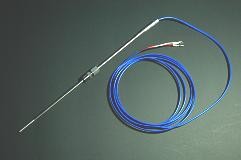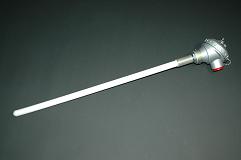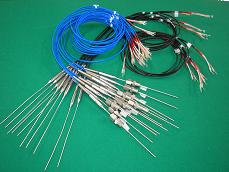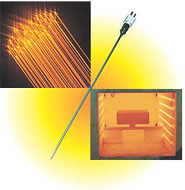|
 |
 |
 |
| Metal Sheathed thermocouple is comprised of metal sheath in which the thermoelectric elements are embedded in highly compacted magnesium oxide (MgO) insulation.
The construction guarantees a superb insulation quality and high resistance to pressure, and has, in addition, an excellent flexibility, which has been given to it by annealing in a proper method |
|
| Types of Thermocouple |
K, E, J, T, N, R |
| Sheath O.D. (mm) |
0.25, 0.5, 1.0, 1.6, 2.2, 3.2, 4.8, 6.4, 8.0 |
| Sheath Material |
SS316L, SS310S, Inconel 600 |
| Class |
JIS Class 1, JIS Class 2 |
| Pair |
Single, Double |
| Hot Junctions |
Type I(Grounded), Type II(Ungrounded), Type III(Exposed) |
 |
| *Please consult us for other sheath material, type of thermocouple and dimension. |
Standard Models of THERMIC Metal Sheathed Thermocouple (Model: TM) |
TMB: Flexible Shield Lead Type |
| TMH: Terminal Head Type |
 |
|
 |
TMES(L): Metal Connector Type | |
TMN: Screwed-in Plain Nipple Type |
 |
|  |
TNDS(L): Quick Connector Type | |
TMNF: Flange Nipple Type |
 |
|  |
 |
 |
Protection tube type thermocouple is comprised of metal or ceramic protection tube in which the thermoelectric elements are embedded with beaded ceramic insulators. Proper selecting of protection tube and insulators in consideration of measuring condition is the key for the measurement of temperature. |
| Types of Thermocouple |
K, E, J, T, N, R |
| Conductor Dia. (mm) |
0.32, 0.5(Type R), 0.65, 1.0, 1.6, 2.3, 3.2 |
| Class |
JIS Class 1, JIS Class 2 |
Standard Models of Protection Tube Type Thermocouple (Model: TE) |
TE12: Metal Protection Tube Type |
|
TE22: Ceramic Protection Type
with Metal Support |
 |
|
 |
TE13: Screwed-in Metal Protection
Tube Type with Nipple |
|
TE23: Screwed-in Ceramic Protection
Tube Type with Nipple |
 |
|
 |
TE14: Metal Protection Tube Type
with Fixed Flange |
|
TE24: Ceramic Protection Tube Type
with Fixed Flange |
 |
|
 |
 |
 |
Ceramics-tubed wires or mineral insulated cables have conventionally been used in harsh environments. However, they posed serious problems in flexibility, connections, and the ratio of outer cable diameter to conductor diameter. Yamari has launched a flexible ceramic-insulated thermocouple wire, achieved through a new fabrication process, SLPC using a liquid phase process similar to an electrostatic spattering method. |
| 1. Easy to handle - - - - - - - - |
No breakage at joints in insulators |
| 2. Space Saving - - - - - - - - |
Virtually same diameter as bare wire |
| 3. Lightweight - - - - - - - - |
Virtually same weight as bare wire |
| 4. High Flexibility - - - - - - - - |
No insulators are necessary |
| 5. Low out gassing - - - - - - - - |
Usable in super vacuum atmosphere |
Semiconductor processing equipment |
Temperature distribution measurement of silicon wafer and P.C. board |
Vacuum equipment |
Temperature measurement of P.C. board on spattering equipment, and various evaporation equipment |
CVD equipment, Heat treatment furnace, etc. |
Temperature measurement of precision sintering furnace, etc. |
| Type of Thermocouple |
K |
| Diameter (mm) |
0.2, 0.32 |
 |
※We make hot junction upon request.
※Improper EMF may be generated, if hot junction and leads were made without removing ceramic layer. |
| CERATHERMO Thermocouple with hot junction |
 |
| ※Any length can be made upon request. |
 |
 |
A new type K thermocouple conductor was jointly developed with a world-class manufacturer of thermoelectric wire to improve long-term stability and service life at elevated temperature in reducing atmosphere. AD-THERMIC is a MI thermocouple cable comprising of this advanced thermocouple conductor and Inconel 600 sheath with MgO insulation. An excellent long-term stability and longer service life compared to the conventional MI thermocouple cables have been proven on our field test using heat treatment furnace and reducing furnace. |
| 1. |
Excellent long-term emf stability in hydrogen and carburizing atmosphere at elevated temperature. |
| 2. |
Prolonged service life in continuous operation. |
 |
 |
| The demand for measuring very high temperature in research laboratories, specialized furnaces, and in other high temperature experimental and industrial applications has grown dramatically in recent years. In response to this demand, Yamari Industries has been providing its Tungsten Rhenium thermocouples and expert knowledge to customers needing accurate measurements of high temperatures in a wide range of fields. Now, Yamari is pleased to announce it has developed a new type of Tungsten Rhenium thermocouple, “VAC-Curate 2100”, in conjunction with a world class Japanese manufacturer of quality alloys and can supply thermocouple elements conforming to ASTM standard E988-96 in matched pairs. |
|
 |
| Advantages of the Tungsten Rhenium Thermocouple |
| ● |
Compared to platinum elements, the tungsten rhenium thermocouple has a high and relatively linear thermal emf output. |
 |
| ● |
Tungsten Rhenium can measure temperature over a range extending to 2,300℃. |
 |
| ● |
Noble metal thermocouples are usually used in oxidizing or inert atmosphere. Tungsten Rhenium thermocouples are suitable for use in reducing or inert atmosphere and in vacuum or nuclear environments. |
|
| Characteristics of the VAC-Curate 2100 Thermocouple |
| The graphs below compare conventional Tungsten Rhenium thermocouple against Yamari’s VAC-Curate 2100 thermocouple.
As shown, the VAC-Curate 2100 outperforms conventional Tungsten Rhenium both on initial tolerance and emf drift.
|
|
|
|
Tolerance comparison between a conventional Tungsten Rhenium thermocouple and Yamari VAC-Curate 2100 thermocouple, using the standard thermocouple calibrated by NIST. |
 |
Measured errors at the freezing point of Cu(1084.62℃) after 3 hours and 10 hours exposure in an argon atmosphere. |
|
|
 |
Physical Properties of the VAC-Curate 2100 |
|
TYPE |
| PROPERTY |
W・5%Re |
W・26%Re |
| Melting point (℃) |
3375℃※ |
3021℃※ |
| Specific Gravity |
19.4 |
19.6 |
| Resistivity μΩ・cm(30℃) |
12.6 |
28.8 |
| Coefficient of Expansion(0~100℃) |
4.6×10 -6 |
4.9×10 -6 |
| Specific Heat (30℃) |
0.131 |
0.132 |
※Melting points refer to W/3%Re-W/25%Re as the references listed do not provide values
to W/5%Re-W/26%Re alloys.
References: Monograph Series on Alloy Phase Diagrams 7
「Phase Diagrams of Binary Tungsten Alloys」THE INDIAN INSTITUTE of METALS |
|

